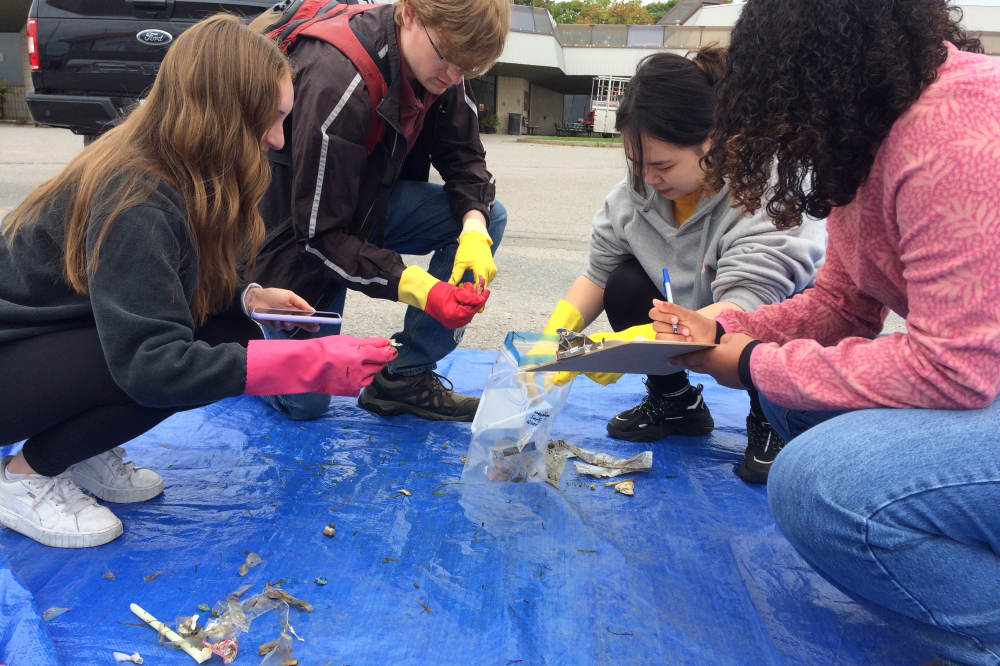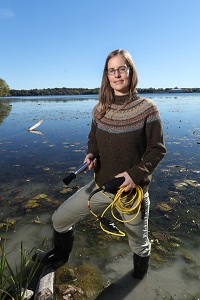Queen’s joins Lake Ontario cleanup project
October 25, 2022
Share
Each year, around 10 million kilograms of plastic flows into the Great Lakes. Queen’s researchers and students are joining a regional effort to deeper understand and tackle this problem: the Great Lakes Plastic Cleanup (GLPC) network, an initiative led by the Council of the Great Lakes Region and Pollution Probe.
The program, launched in 2020, aims to remove plastic waste from the water and raise public awareness of the impact plastic pollution has on the environment. Their year one report highlights some initial results on plastic debris collection and analysis in cities like Toronto, Hamilton, Rockport, Cobourg, and others.
Last July, the project arrived in Kingston, through a partnership between Pollution Probe and the City. Two Seabins – “trash skimmers” designed to collect debris from the water – were then installed at Portsmouth Olympic Harbour Marina and Confederation Basin Marina. Queen’s researchers from the Beaty Water Research Centre (BWRC) were called upon to lead the analysis of the debris and, moving forward, BWRC will be the hub for local GLPC efforts.
“Plastics are a major problem in our natural waterways and can be easily transported by waves and currents,” says Ryan Mulligan, professor of civil engineering and director of BWRC. “Our researchers have been working to study contaminants and water flow in the Great Lakes, so this initiative is very exciting.”
Professor Diane Orihel (Department of Biology and School of Environmental Studies) and her students are involved with characterizing the plastic debris collected in Kingston’s Seabins. These waste audits feed information into a Great Lakes-wide database that allows researchers to understand what plastic pollution in the Great Lakes looks like.
“Data on the kinds of plastics that are floating in surface water of Lake Ontario and other Great Lakes give us insights into the sources of plastic pollution to lakes, which in turn, helps to inform policy decisions to address this problem” says Dr. Orihel, who is the Queen’s National Scholar in Aquatic Ecotoxicology. For example, data from the GLPC network helped inform Bill 228, Keeping Polystyrene Out of Ontario’s Lakes & Rivers Act (2020), which now requires dock styrofoam to be fully encapsulated.
The Great Lakes Plastic Cleanup is working to connect with the local Kingston community to raise awareness and cleanup our aquatic environment. The network counts on community volunteers to help audit the debris found in Kingston – a good example of how to engage local citizens in research and conservation activities. “This is an excellent opportunity for Queen’s students to meaningfully engage with our community and do their part to help raise more awareness of plastic pollution,” says Dr. Orihel.

The plastics collected in the Seabins could also potentially be used for other research projects. For example, Dr. Orihel is considering ecotoxicological experiments at the Queen’s University Biological Station (QUBS) to understand how plastics in Lake Ontario may affect the health of local fish and frog species. She is also in touch with professor George DiCenzo (Biology), one of the leads on the OpenPlastics project, to explore the community of bacteria that colonize this plastic.
Freshwater pollution science
The research on plastic pollution in the Great Lakes builds on the expertise Dr. Orihel’s acquired through previous work. For the past 20 years, she has been studying environmental contamination of freshwater ecosystems. Her research has advanced science and policy on mercury, flame retardants, and the nutrients that cause harmful algal blooms. Since joining Queen’s in 2017 as the National Scholar in Aquatic Ecotoxicology, her research program has focused on the impacts of oil sands mining on aquatic wildlife, as well as the consequences of accidental spills of pipeline oil to inland lakes. Her team is now involved with an ambitious study to understand the potential harm caused by plastic pollution – the largest experiment of its kind.

Dr. Orihel is currently co-leading the pELAstic project, a globally unique large-scale study funded through NSERC’s Plastic Science for a Cleaner Future program, involving several universities, government agencies, and non-profit organizations. In the pELAstic project, scientists are conducting experiments at multiple scales – from mesocosm to whole lake – to understand the fate and ecological effects of microplastics in freshwaters. This work is being conducted at QUBS and at the International Institute for Sustainable Development Experimental Lakes Area (IISD-ELA) in Northern Ontario.
While a great deal of effort has been put into understanding plastic pollution in the ocean, it is only in the last decade that scientists began to study microplastics in freshwaters. “Microplastics have now been documented in surface water and sediment of lakes and rivers on most continents and in hundreds of aquatic species,” says Dr. Orihel. “But the jury is still out as to whether this widespread contamination is causing harm to freshwater life”. This is exactly what the pELAstic project is working to find out.